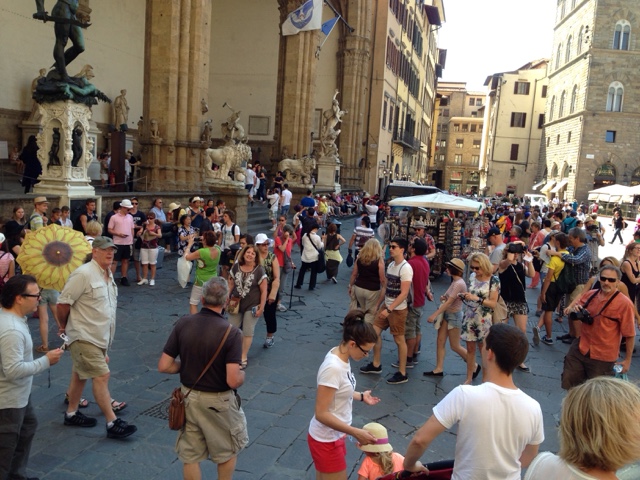June 4, 2015
Florence's Duomo is the city's most iconic landmark. The square is mostly traffic-free so you can walk around and gape.
Capped by Filippo Brunelleschi's red-tiled cupola , it's a staggering construction whose breathtaking pink, white and green marble facade and graceful campanile (bell tower) dominate the medieval cityscape.
We did climb up into the dome! More on that later.
Palazzo Vecchio
It has the appearance of a fortress, topped by a huge open gallery, from which rises the slender tower known as the Arnolfo tower.
We climbed that, too.
Palazzo Vecchio, after having been the seat the seat of the town authorities, became the home of the Medici family.
Cosimo I de' Medici (12 June 1519 – 21 April 1574) was the second Duke of Florence from 1537 until 1569, when he became the first Grand Duke of Tuscany.
The Loggia Della Signoria is a unique example of an open-air sculpture gallery containing Antique and Renaissance art including this friendly lion.
The Loggia is across the square from the Palazzo Vecchio and statue of Cosimo.
Crowds enjoy the Palazzo Della Signoria.
In another area or Florence, visitors to Il Porcellino put a coin into the boar's gaping jaws with the intent to let it fall through the underlying grating for good luck. They rub the boar's snout to ensure a return to Florence, a tradition that the English literary traveller Tobias Smollett already noted in 1766, which has kept the snout in a state of polished sheen.
Ah, divine, that Duomo!
The Uffizi Gallery
This greatest collection of Italian paintings anywhere features works by Giotto, Leonardo, Raphael, Caravaggio, Titian, Michelangelo and Botticelli.
Around every corner is an "old friend", a painting that we know.
Some favorites:
The Adoration of the Magi (1423) is a painting by the Italian painter Gentile da Fabriano. The work, housed in the Uffizi Gallery in Florence, Italy, is considered his finest work.
The Holy Family with the infant St. John the Baptist known as 'Doni Tondo' 1507, by Michelangelo (1475 - 1564).
Tondo is Michelangelo's only recorded panel painting. The Holy Family has a sculptural quality. John the Baptist, looking on from behind a low wall, links the scene to the background in which a group of young male nudes adopt poses derived in part from Ancient statuary. The tondo was purchased by the Medicis in 1594.
The Madonna of the Goldfinch is a painting by Italian renaissance artist Raphael, (1505-1506). A 10-year restoration process was completed in 2008, after which the painting was returned to its home at the Uffizi in Florence.
Peeking out the upper storey windows of the Uffizi I saw the Ponte Vecchio.
Built very close to the Roman crossing, the Ponte Vecchio, or Old Bridge, was until 1218 the only bridge across the Arno in Florence.
The current bridge was rebuilt after a flood in 1345. During World War II it was the only bridge of six across the Arno that the fleeing Germans did not destroy. Instead they blocked access by demolishing the medieval buildings on each side.
On November 4, 1966, the bridge miraculously withstood the tremendous weight of water and silt when the Arno once again burst its banks.
Back to the paintings!
The Madonna of the Long Neck is an Italian Mannerist oil painting by Parmigianino begun in 1534.
It remained incomplete on Parmigianino's death in 1540.
Florence provides us free fizzy or plain water!
We rode bicycles to and from the campground along the Arno River everyday.














No comments:
Post a Comment